
A photo I've been waiting to see from the RNC in Tampa, unidentified source via brian boucher
factchecking update: you know, I'm gonna go with: this debt clock photo is as true as this one.
August 30, 2012

A photo I've been waiting to see from the RNC in Tampa, unidentified source via brian boucher
factchecking update: you know, I'm gonna go with: this debt clock photo is as true as this one.
August 29, 2012
Well look what I unearthed while reorganizing my books in storage. The Fall 1966 issue of Art Voices, a short-lived magazine that, I swear, I bought for the articles.
Seriously. It's the issue where Robert Smithson & Mel Bochner published "The Domain Of The Great Bear," their photo-essay/article-as-art expedition through the Hayden Planetarium. I mean, sure, you could read it in Robert Smithson: The Collected Writings, but don't you want to see it printed slightly bigger?
Anyway, in the short features section up front, right before Lawrence Alloway's essay on early space age films, is this awesome story by pioneering downtown journalist Walter Bowart about a secret, artist-run tattoo parlor called Apocalyptic Tattoo. It's not turning up online anywhere, so I'm putting the whole, short, thing after the jump:
August 28, 2012
In response to Olia Lialina's post last week about screwy reproductions of her c.1996 lo-res digital imagery, Ben Fino-Radin writes about how Rhizome deals with archiving and documenting digital art in its native formats, platforms and resolutions: by photographing it.
This very issue of how low-resolution digital images gum up the hi-res assumptions our visual systems are built on is was one of the unexpectedly central discoveries of making Untitled (300 x 404) project. Though initially, at least, the losses and distortions of moving a thumbnail-sized jpg through the media channels were for me evidence or symbolic of the information that's lost through ridiculous copyright restrictions, and not so concerned with archiving or perpetuation.
But that's not important right now. Because just a few days before reading about Fino-Radin's archival challenges, I stumbled across another data-driven use of old-school photography, on Project Echo.
I just received a rare print copy of the 1961 Bell Systems Technical Journal devoted to Project Echo, which has a dozen papers reporting Bell Labs' findings and processes of tracking and operating an inflatable, reflective communications satellite. What's extraordinary about the papers is what's always fascinated me about the Echo satelloons in the first place: they were analog experiments done largely by hand, and before computers were practical tools for real-time tasks.
And so, for example, in order to record all the satellite tracking data and readouts at the Holmdel, NJ receiving and transmission station, they took pictures of the control panel. Here's the description from Bell Labs project engineer Dr. William C. Jakes' paper [available from dtic.mil as a pdf]:
In order to have a record of the positions of the various moving elements of the system during a satellite pass, each element was provided with synchro read-outs which were periodically photographed. Pictures were taken at one-second intervals of a panel carrying the two-speed azimuth and elevation position dials for the DAC, M-33 (optics), 60-foot dish, and horn antenna. A Greenwich Mean Time clock also appeared in the photographs. Position angles could be read to +/- 0.01 degrees, and time to 0.5 second. An enlargement of one frame of such a record is shown. [above]But wait, there was more:
The 60-foot dish and horn antennas were each equipped with a bore-sight camera [!] that could be started at will whenever the satellite was visible. Pictures were taken at four frames per second, and included a reticle for indicating angular offsets to an accuracy of +/-0.01 deg. and a time-coded counter.I have contacted archivists for Bell Labs, and unfortunately, no such operational film records have survived. In the company's possession, anyway. But I am still looking.
August 27, 2012
My great great grandmother had an awesome name: Mary Argent Mozingo. She was married to the equally well-named Ruffin Sullivan. They were country people, farmers, I suppose, in Wayne County, North Carolina. I knew their daughter, my great grandmother, who lived to be 105, but I never heard her talk of her parents. We found their names when we were in the market for names, and were surfing through family history records. My wife vetoed Mozingo, and my grandmother nixed Ruffin with a swiftness that hinted at family stories that did not get told very often.
While I was still campaigning for Mozingo--just, you know, as a second or third middle name, a fun option, maybe? no?--my mother did say that her grandmother always insisted her mother's name was Mozzinger. Or Mottsinger, and if it weren't for some ignorant census clerk somewhere who couldn't hear or spell right, we wouldn't even be having this conversation. In any case, it's not Mozingo.
This was the woman who eventually edited out the stories of working in a cigar factory in Richmond as a young girl, where she won five dollars once for the quickest rolling. And who destroyed oral history tape recordings of her family's history because of, well, I guess we can only speculate now, since those stories have been lost.
And there's no chance that a lone census taker messed up, Ellis Island-style, on the Mozingo. If anything, my ancestors' insecurity about Mozingo is one of the prime indicators of their true Mozingoness.
As LA Times writer Joe Mozingo found out, when he went searching for the origins of his name, which he'd always heard was Italian. Other Mozingos heard it was Portuguese, or Basque. Obviously, to almost everyone not named Mozingo, that is, Mozingo is an African name, brought to early colonial Virginia by one Edward Mozingo:
Edward had been a servant to Col. John Walker, a member of the colony's legislature. When Walker died in 1669, his widow inherited Edward and remarried a powerful Virginian, John Stone.Joe Mozingo's three-part story of uncovering the Mozingo truth overflows with examples of hardship, racism, insecurity and denial that runs so natural and deep Americans have been soaking in it for centuries.Edward sued Stone for his freedom. Little is said about the lawsuit in the court record, only that there was an appeals hearing in the high colonial court, that "Divers Witnesses" testified and that the judges concluded "Edward Mozingo a Negro man" had served his term after 28 years of indenture.
And that's just the white Mozingos. People whose identity and racial worldview don't have room for the complexities of rural intermarriage in 18th century America. For the black Mozingos, meanwhile, the countervailing impact of generations of discrimination, opportunity, passing, and self-loathing still play out in a Goldsboro, NC barbecue restaurant--which turns out to be the same place we've stopped for lunch every summer on the way to the Outer Banks.
The ways family functions as a machine for transmitting memory are one subject of my set of 12 short films, The Souvenir Series; I think I have to add the way family desperately tries to keep things silent for centuries to the mix, too.
In Search Of The Meaning Of 'Mozingo', part 1, part 2, and part 3 [latimes via my cousin cara]
August 23, 2012
I'm done waiting. This Europera 1 & 2 post is apparently not going to write itself.
The Ruhr Triennial opened last weekend with what is only the third [production and fourth -ed.] staging of John Cage's grandest* composition, the 1987 Europeras 1 & 2. It's basically a chance operations tour de force that runs the entirety of the European opera canon--arias, stories, costumes, props, sets, lighting, libretti, staging, orchestra--through the I Ching wringer, which performance is conducted, so to speak, by the cues of a 2.75-hour clock. As Cage put it, "For 200 years the Europeans have sent us their operas. Now I'm returning all of them."
All six performances in the Triennial's home venue, the vast, repurposed industrial Centennial Hall Bochum sold out immediately. So far three have happened, directed by the director of the entire Triennial, avant-garde composer Heiner Goebbels.
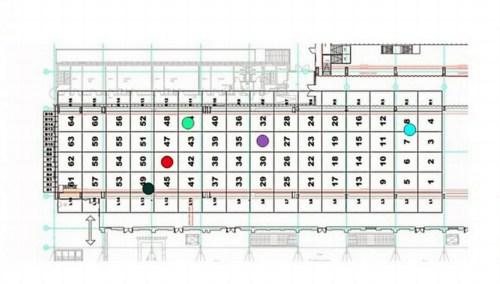
So I've been monitoring the reviews jealously, and with some indignance. The scale and ambition and significance of the work is being respected--the work has only ever been performed in Germany--but it seems that both critics and directors alike still struggle with the vocabulary and the very concept of Cage's chance-driven work.
In the only English-language review I've found so far, The Financial Times' Shirley Apthorp describes Europeras' "extravagant evening of associative nonsense" as both "chaos" and "minutely choreographed absurdity." Writing for FAZ Eleonore Buening criticized Goebbels for putting the "chaos Cage conceived a quarter century ago back in a Museumsvitrine." If I read my German correctly, "The director placed too little confidence," Buening writes, "in the expiration of the clock, the will of the participants, or even Comrade Chance." And did Cage ever have a better comrade?
I have never seen Europera 1 & 2, but I've been studying up on them for the last year or so. The original staging, commissioned in 1985 by the Frankfurt Opera, was the dissertation subject of Laura Kuhn, who was involved in the production, and who has since become the director of the John Cage Trust.
Europera 1 & 2 strikes me as a simultaneous negation and celebration of opera as an art/theatrical form, but also as a cultural and historical institution. His chance-based composition removes narrative, character arcs, literary and stage conventions, and authorial intentions from the experience of a performance. Chance is not chaos or absurdity; it's a different syntax. How does any opera performance seem if you don't know the story or speak the language? Would you ever call it chaos or nonsense?
An opera diehard may want to identify the source of every passing prop, aria, or orchestral passage in Europera--did the Stump The Operahead trivia quiz during the intermission of the Met's weekly radio broadcast ever tackle Cage? Just like a moviehound might try to flag the source of every clip in Christian Marclay's The Clock. But that risks missing Cage's point [which is not Marclay's]: that the experience of the montage has quality and meaning and value in itself, apart from the original content and its juxtapositions, not because of them.
And maybe critics actually are better attuned to this now, and the problem [sic] is just/still the directors. In FAZ, discussing the "Children's Jury" who Goebbels convened to award unconventional prizes during the Triennial, Buening found a new twist on the classic MTV Crisis when she worried that the media-saturated, "Multi-tasken" Kids These Days might be bored by Cage's 1980s jump cut revolution. After watching a rehearsal of Europera Ruhr Nachtrichten writer Julia Gass said Cage foreshadowed the "TV Zapp Era"; actually, he was soaking in it. Cage's vision of the future was surfing the 400-operatic channels of the past.
Europera may be Cage's most ambitious and explicit appropriationist work. According to Kuhn's firsthand account of the making of, Cage, relying on the collection of Lincoln Center's library, determined to include only operas that were in the public domain. For the flats and sets, he had researchers in Germany compile engravings and illustrations of composers, architecture, and animals from pre-20th century books. With these copyright-free source sets established, Cage used chance operations and a time log to generate the content of the opera.
And this, apparently, is where Goebbels' otherwise extraordinary production falls short. I'll try to account for the differences--or more precisely, the changes--between Goebbels' version and Cage's, the immediately apparent one is his replacement of simple, graphic flats with actual operatic sets. Buening sees this as too deterministic, too willfully absurdist [in the mold of Robert Wilson, who, inexplicably, is the Triennial's English talking head for Europera], and stuck to the cliches and oneliners of operatic theatricality. And too much of the director's own indulgences, which runs diametrically counter to Cage's purging intentions.
It's a perennial problem with Cage's interpreters, who take the indeterminacy of his compositions as license to do whatever they want. Not coincidentally, that sounds like exactly the criticism voiced in OMM by Sebastian Hanusa over the previous production of Europeras 1 & 2 at the Hannover State Opera. [It opened in October 2001, and I confess, I was not paying much attention to German opera gossip at the time.] According to Hanusa, Lowery kept the aria singers offstage, and instead of the chance-derived staging, he created various storytelling set pieces. It sounds almost as bad as Cage's sabotaged NY Phil debut in 1964.
But it's better than nothing? I don't know. Is it the kind of thing you can watch on DVD? Will Europeras ever be staged in the US? [YES, SEE BELOW.] Frankly, we may still not be ready for it. Or maybe we've superseded it; with the right code and a few browser tabs on YouTube, we can generate our own Europera anytime we want. Man Bartlett's #12hPoint, I'm looking at you.
UPDATE/CORRECTION: Thanks to DJW for correcting me; Europeras 1 & 2 was staged in the US. Christopher Hunt brought the original Frankfurt production to Summerfare at SUNY Purchase in 1988. According to John Rockwell's bemused NY Times' review, the New York version, which took place on a grander stage, was actually closer to Cage's original vision, which the Frankfurt Opera had to rework after its main theater was damaged by arson just before the Europeras' premiere. Anyway, more to come on that.
* OK, the 639-year-long organ performance of As Slow As Possible, also from 1987, at St. Burchardi church in Halberstadt is also pretty grand. But I'd argue its grandeur is more the performance, not necessarily the composition.
August 22, 2012
From Allan Sekula's response to Nato Thompson's "Debating Occupy" roundup in Art in America [Jun/Jul 2012, on scribd, which oy]
The "art world" is a small sector of culture in general, but an important one. It is, among other things, the illuminated luxury-goods tip of the commodity iceberg. The art world is the most complicit fabrication work-shop for the compensatory dreams of financial elites who have nothing else to dream about but a "subjectivity" they have successfully killed within themselves. Thus the pervasive necrophilia of the art system. Alfred Jarry spoke at the turn of the 20th century of a "disembraining machine." We can speak now of a "self-embalming machine." Hook yourself up to the dripfor the antiquarian future.Will do.
Meanwhile, in the summer of 2004, in advance of the Bush/Kerry election, Frieze did a similarly structured but more abstract roundup of artist comments about art and politics, which makes for a sobering, ambivalent read. Here's Paul Chan's response to the carefully worded question, "Can you give an example of a piece of art you think is politically effective?"
When the Soviets invaded Czechoslovakia in 1968 to quash the 'Prague Spring' (a series of economic and free speech reforms that liberal-minded Czech communist leaders enacted), the people of Prague were overwhelmed and could not resist militarily. So they did the next best thing: they painted all their street signs white. For eight months the Soviets could not arrest resistance leaders, shut down pirate radio and television stations or break up organized meetings, all because they couldn't fucking find them.Which is true? I guess? The Wikipedia entry for the Prague Spring cites Paul Chan. But from his Mar. 2007 Artforum text, "Fearless Symmetry," [which only shows up on Google in this wonky page and] which ends like this:
But how do we verify, following Rancière, the efficacy of our practice? How do we test the work so that we know it is something made that has become more than something simply made? If we use Rancière as a departure point, perhaps a confrontation is in order. That is to say, the place to verify the practice of equality in the pursuit of a form of freedom (which seems to me like a pleasing if wonky definition of art) might well be a confrontation with a force of order that divides and partitions the ghostly whole back into measured forms of understanding and consumption. If the work is indeed a work, it will resist this partitioning at every turn and claim for itself the autonomy that can come only from the practice of imagining the presence of this now not-so-secret equality in every line, shape, color, and sound. Confronted with such a presence, the police order that longs to divide in order to own can only blush: out of frustration, out of confusion, perhaps even out of fear. But tell me-honestly-when was the last time you blushed looking at art?Whoa also this, same question to Kara Walker, from the Frieze thing:
I like to think of Donald Judd's Marfa complex as exemplifying the strivings of White patriarchy. But that's just me; I don't think he intended that.
August 21, 2012

Monument to Cleopatra, 1988, currently on view at Michael Werner
I've been thinking a lot about James Lee Byars lately, for a whole variety of reasons. He's been problematic for me. I've always felt suspicious that his sculptures, all gold leaf and marble and monumentally deluxe, are not just decorative art, but decorator art [most excellent people, but you know what I mean.] And his camp and vanity, with all the lame´, read to me like the Zen Dali artist's version of the court jesterish, affectations decorators use to peddle their marked up wares. All of which makes the relentless pursuit of Perfection, Truth & Beauty seem a little, again, problematic. And though I obviously can't blame Byars for him, the ascendance of Terence Koh hasn't helped the case for monochrome life-as-art.
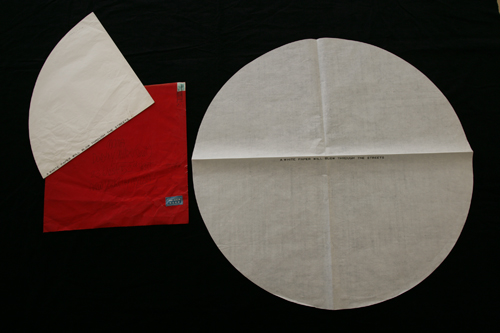
A letter/multiple dated Dec. 5, 1966, from James Lee Byars to Dorothy Miller, with text: "A white paper will blow through the streets." via MoMA Archives
But then I found out about all the wild letters. In 2007, MoMA Archivist Michelle Elligott put together a show of Byars' art object-based correspondence with longtime painting & sculpture curator Dorothy Miller, just one of the many people he corresponded with--or at least sent stuff to--over the decades. Which are obviously and unabashedly ridiculous and awesome at the same time, a simultaneous state I had never before considered for the rest of Byars' work.
And just yesterday, in fact, I think I figured out something else, related to another of the things that'd bugged me about Byars: his fantastical bullshitting. Like, to cite just one example, what was up with what Byars' official bio calls his "notorious 1958 exhibition in the stairwell of New York's Museum of Modern Art."
Roberta Smith wrote in Byars' 1997 Times obituary that Miller "arranged his New York debut, a show of folded-paper pieces displayed in an emergency stairwell of the museum for a few hours one afternoon."
And though the Museum's press archive has no record of it, Elligott mentions the "show" in the story of the 26-yo artist coldcalling from the front desk:
After seeing a work by Mark Rothko, Byars became determined to meet the artist, and in 1958 he hitchhiked from Detroit to New York and presented himself at The Museum of Modern Art, requesting an introduction. Miller was called down to meet with him. Legendarily, that same year Byars had his first exhibition at a U.S. museum, when Miller allowed him to briefly install his large works on paper in the Museum's emergency exit stairwell. From this point forward, Byars considered Miller an important mentor and turned to her repeatedly for support.That "Legendarily" is exactly the buggin' I'm talking about. Elligott notes a stairwell mention in a 1967 Byars letter as "likely a reference to a show he allegedly mounted in a Museum stairwell in 1958." And Elligott expanded on her skepticism of the stairwell "show" in a 2008 interview:
I think the stairwell exhibit story is somewhat unlikely, and that it is quite probable that Byars propagated this legend after some sort of small incident. Regardless of what happened, I do believe that Byars aggrandized the event, much as he continually cultivated his larger-than-life personality.Which is better. I mean, artists, they're gonna do what they do, but I don't want my museums to be lying to me, or to be just going along with the hype.
Which brings me to yesterday, when I finally cracked open the little catalogue from Byars' 1995 Fondation Cartier show. And read psychoanalyst/critic/PS1 adjunct curator Jean-Michel Ribettes, seeming to swallow Byars' story whole by just cold referring to it as "his first show in an American museum--the Museum of Modern Art in New York." But then, finally, Ribettes has some more details, presumably heard from the artist himself:
Byars's enormous works in ink on Japan paper were hung on the five-storey fire escape. The curator, Dorothy Miller, not only agreed that the show would last just a few hours, but she and other collectors (like architect Philip Johnson and David Hayes) purchased all the pieces, which Byars himself delivered to their houses that very night, crisscrossing New York into the early hours of the morning.So it's less of a "show" and more of a "sale." And this appropriated but unsourced Byars bio says Miller bought "two paper works and allows him an exhibition lasting a few hours." And how's this for five-storey fire escape? At MoMA in 1958? Which would've gone right up against the P&S department's window?
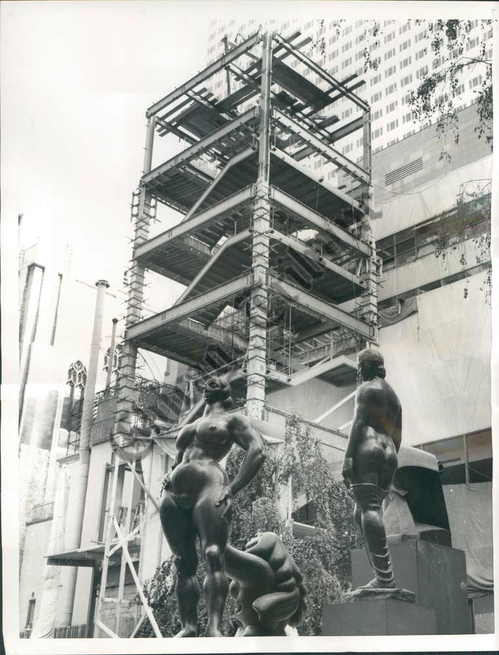
And here is a tall [1.8m], if not enormous, work on Japanese paper, dated 1959, which Philip Johnson gave to NYU in 1969. It was included along with several related, smaller, ink drawings, in the Grey's "NY Cool" show of abstract non-expressionism.
So we have a charismatic, young hitchhiker calling from the lobby, and probably dropping names of his Japanese mentors, folks like Morris Graves and Soetsu Yanagi, and asking to talk to Rothko. And when you bring him upstairs, he unrolls some of his drawings, which, hello, he's a 26yo hitchhiker, are probably pretty cheap. And maybe PJ and Hayes passed by and went in for a drawing, too. From the Zen monk who'd set up shop and was now meditating on the fire escape outside Dorothy's window. Now I am OK with this. But I would not call it an exhibition.

Which is all good, because what Byars showed at the Cartier Foundation was The Monument To Language a 3-meter wide gold-leafed bronze sphere. And you know how I am about big, superlatively beautiful, shiny balls.
2007: James Lee Byars: The Art of Writing [moma.org]
August 20, 2012
Ooh, the party conventions are coming, Sforzian Fashion Week, and the NYTimes' advance team is reporting on the GOP advance team whose once-every-four-years job is to make the Republican candidate for president come across as a man of the people on TV. Here's Jeremy Peters:
The campaign aides are determined to overcome perceptions that Mr. Romney is stiff, aloof and distant. So they have built one of the most intricate set pieces ever designed for a convention -- a $2.5 million Frank Lloyd Wright-inspired theatrical stage. From its dark-wood finish to the brightly glowing high-resolution screens in the rafters that look like skylights, every aspect of the stage has been designed to convey warmth, approachability and openness.Yes. OK.
This time, Samantha Stark reports in the Times video, the stage is now fronted by open, non-hierarchical stairs reaching down into the crowd. Which, yeah no, ask McCain, Bush, and Dole about that convention convention.
What is actually different is that the 13-screen video wall is now all asymmetrical and casual-like, with all the screens "framed in dark wood to give the feeling of looking into someone's living room."
Why, it's practically a Sforzian frame cluster, a slightly enlarged version of the one the Romneys have on the grand piano at Lake Winni.
If you can see any FLW, please let me know, because all I can see in Edward Linsmier's sexy still and video images is Herbert Bayer's all-encompassing field of vision [above]. Maybe a Bauhaus reference is too heady [or foreign] for Romneyvolken to cop to. Or maybe they're wary of acknowledging the importance of the fundamentally subjective viewing experience they're trying to manipulate.
Except, oh wait, that's the whole point of the show, the event, and the article: letting us know how it'll be just you and me, America, TV-hangin' living room to living room with our bestest, richest friends.
More than hang, though, Linsmier's images of the set's big, test-pattern-y bands of glowing color, stacked against each other like that, with silhouettes of roadies all around, make me want to paint. Crank out a whole $#)%ing frame cluster of to-scale paintings.
Stephen Prina meeting Olafur Eliasson at Liz Deschenes' place, with a cameo by Jeremy Blake.
Romney Campaign works feverishly to project relaxed image [nyt]
August 18, 2012
American grain-fed beef will still remain the number one choice of Americans who dine out. Health food fanatics with bogus credentials will continue to slam producers and consumers of beef for destroying the environment and the health of children who are supposedly being poisoned by red meat when organic vegetables, tofu and soy milk are their answers to the world's health problems. More and more pressure in the form of increased year around recreation demand by citizens cloistered much of the year in their Wasatch Front and Southern California neighborhoods will test the patience of ranchers and farmers in the valley who find their gates left open, livestock scattered, sprinkler pipes shot full of holes, crops trampled by four-wheelers and fences cut so hunters can get closer to that "real good hunting spot."excerpted from Verl Bagley's extensively researched history and future of "Beef Husbandry in Grass Valley," p. 222 of the impressive if not quite comprehensive Grass Valley History, Including the Communities of Box Creek, Burrville, Greenwich, Koosharem, published privately in 2005, which I saw a heavily used, duct-taped copy of near the register at the Koosharem Cafe the other day. And when I inquired about it, the lady helping me called down to the store to see if they had a copy. And then she called over to Carol's place, and sure enough, Carol had a copy I could buy, did I know Carol? And that's when I had to confess that until she said it on the phone just then, I was unsure how to pronounce Koo-SHARE-em, we were just on a quick, first family history visit. But Carol was right down the road, and sure enough, she answered the door with a copy, and was surprised to take money, didn't I pay down to the store?...
One thing that won't change is that there will always be some young men or women who are willing to sacrifice guaranteed vacations, retirement programs, forty-hour weeks and twelve holidays a year with pay, just for the challenge and satisfaction of being a rancher/farmer. The drive or motivation to be a provider of food and fiber for a nation is still alive in a few young people in Grass Valley. May that hunger to work with the soil and the beasts never be lost or destroyed.
In any case, an unexpected and invaluable resource for my research into the contentious history of irrigation in and around Burrville.
August 14, 2012
This is awesome. Someone flew a banner over a Paul Ryan event in Lakewood, Colorado, carrying a @PaulRyanGosling-esque quote, "Hey Girl, Choose me, lose choice." And though he didn't know what it was, CNBC reporter @EamonJavers tweeted a photo of it.
We're all Scott Sforzas now.
Banner Above Paul Ryan-Led Event: 'Hey Girl, Choose Me, Lose Choice--P. Ryan' [theatlantic via @alexismadrigal]
August 13, 2012
So I'm walking to the lodge at Snowbird the other day, and they're sealing cracks in the parking lot with tar on the ends of these long stick/wand things, and suddenly it's all palimpsests and Brice Marden all over the place.
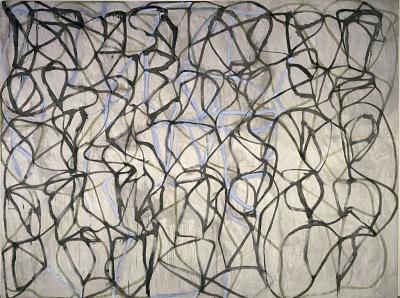
Cold Mountain 2, hirshhorn.si.edu
August 9, 2012
I stumbled across this teacher's manual, published by NASA in 1976, part of a middle school curriculum that made the latest scientific understanding available to students.
Of all astronomical phenomena, supernova have been observed, if not understood, for thousands of years. Ancient Chinese astronomers apparently called them "guest stars." So they make interesting markers for tracking the changing view of the vault of heaven/sky/space/universe.
It's also kind of interesting to see how little was actually known about supernova, even during my lifetime.
But mostly, I liked this for the cover, which reminds me a bit of the London 2012 logo. The book was put out by NASA's Educational Programs Division, but there's no designer mentioned. The awesome, old "worm" logotype was, of course, designed by Danne and Blackburn.
PDF available: The supernova: A stellar spectacle, 1976 [ntrs.nasa.gov]
August 6, 2012

image via 0823n's flickr
I swear, I've tried to keep it all on Twitter, but in the wake of Schimmelgate, I can't help feeling that the debate over Jeffrey Deitch's increasingly depressing tenure at MOCA overlooks one of the most damning incidents: Transmission LA: AV Club, the Mercedes-Benz exhibition curated by Mike D that suddenly displaced and delayed the opening of Philipp Kaiser and Miwon Kwon's Land Art show, Ends Of The Earth.
Maybe it's been underexamined, misunderstood, or just quickly condemned as a "marketing spectacle." But I think Transmission LA is actually a show, an unusually pure embodiment of the programming vision Deitch and his patron Eli Broad hold for MOCA, and for art itself. But that means Transmission LA also expands--and complicates--the comfortable moral outrage against Deitch and MOCA; because the forces and assumptions that gave rise to it--art as leisure, entertainment, consumption experience, luxury good and corporate branding project--are already operating across vast swaths of the contemporary art and museum world.
MOCA's own PR weirdness about its [non-]announcement and the ostensible obviousness of the show's marketing objectives contribute to an inaccurate perception that Transmission LA was an impulsive, hastily organized, poorly handled, maybe slightly desperate corporate rental deal: that Mercedes and its ongoing lifestyle branding initiative, The Avant/Garde Diaries, swooped in unexpectedly to save the big, hard-to-fund scholarly show set to open in a few weeks by offering a six-figure proposal for a pop-up show "curated" by their aging rapper, if only the cash-strapped museum had a space available for a few weeks.
In fact, as the LA Times' Mike Boehm reported a couple of weeks after the Mercedes show appeared on MOCA's calendar, such a mix of "celebrity, fashion and youth culture" were "a key reason [Deitch] was hired in 2010." Boehm wrote,
Deitch said he helped plan the festival for its sponsor, Mercedes-Benz, including recruiting Mike D as the curator who will oversee its offerings of art, music and food. Admission is free. With Mercedes covering the cost and making a contribution to the museum, Deitch expects it to generate several hundred thousand dollars for MOCA's more conventional activities, while continuing his populist push."We need to build the museum as a social space," Deitch said in an interview Tuesday at MOCA.

Deitch met Mike D [whose given name is Mike Diamond] in 2010, while participating in a documentary about Jean-Michel Basquiat by the musician's filmmaker wife Tamra Davis. The Daily Beast, writing about the April opening, said "According to Diamond, Deitch called him a year ago to propose that he curate Transmission: LA and has been very hands-on since." So Deitch was working on Mercedes' show at MOCA in April 2011, and no one [sic] knew about it until six weeks before it opened.
But that is not Deitch's only involvement in Mercedes' branding activities. In December 2011, two months before Transmission LA was announced on Mercedes' site, and 3.5 months before MOCA's involvement was revealed publicly, Deitch made a an Avant/Garde Diaries video at Art Basel Miami Beach, along with Theaster Gates.
Ironically, considering the criticisms leveled against him now, Deitch's role in the video is to provide gravitas and historical context. Specifically, it was to anoint The Avant/Garde as the rightful heirs to the "the avant-garde," aka the world Deitch had come up in, the "small community" that was "the art world" in "the early 70s." In other words, exactly the kind of intergenerational baton-passing that 90's veteran, Deitch collaborator, and Avant/Garde-ist Aaron Rose called for in his recent defense of Deitch's MOCA mission. [It's not really relevant, but the video includes Deitch fluff-flubbing Gates' affiliation with the Art Institute, instead of the University of Chicago.]
In his curator's statement in the "official Audio-Visual Club zine" [pdf], explaining how the whole thing came together, Mike D reflects some of Deitch's curatorial light:
When Jeffrey Deitch first approached me about doing this show, the assignment was more simple. It was to pick 10 or 11 artists that I found inspiring, or was inspired by. I quickly, however, spiraled out of control."Pick 10 or 11" "inspiring" artists, add coffee and a DJ, crank "everything up to 11," and you have "the new MOCA," as Mike D put it on a MOCA blog, "a 21st Century institution that redefines how contemporary art is presented in a cultural context." Which is modulated a bit from the way he described the show in April, before the Schimmel hit the fan: a "grown-up theme park, a Six Flags for adults."I decided to be a bit more ambitious and go for a complete sensory experience inclusive of food, coffee, books, film, and many multi-media installations.
...
...I realized the theme had emerged: this notion of how visual art is informed by and inspired by music, and how that then turns back to music. after that, I knew that we also had to have a musical component to the exhibition with DJ nights, performances, etc. to complete the circle.
the food and coffee elements were conceptualized with Jeffrey originally because I thought of the project as two-fold. One is that LA is all about car culture. the tricky thing is to get people out of their homes, so you need to check multiple boxes off in one day and destination. the other is that we're trying to create this all- encompassing sensory-rich environment.
In The Avant/Garde's preview for the show, "TRANSMISSION LA: AV CLUB Concept by Mercedes Benz [! -ed.] Curated by Mike D", Diamond's fragmented, aphoristic narration has been edited together to sound like nothing so much as International Art English, spoken with a recovering rocker patois:
Installations cranking everything up to 11...musicians...visual artists...trying to break it up...so that's not a typical white wall, concrete floor kind of gallery experience.The museum is transformed, the literalization of a dreamscape, where your fantasy of hanging out at your favorite musician's house comes true.An experienced curator would have said, 'There's no way this is going to be possible.' But I didn't know! [muffled laugh of whoever he's talking to] So I just kind of like...'Do it!'"
Experiential, mind-altering fun? Like, my dream of what my house might be like. Like a fantasy of what it would be if you came over. Why don't I meet you, we'll have a cup of coffee, I have the big, old Tom Sachs sound system, and we'll play some music on that.

Image via 0823n's flickr
And right in the middle of the show, waiting to upend your "gallery experience"? The 2013 Mercedes CSC, or Concept Style Coupe. Bet you didn't expect that!
Deitch's show, conceived by The Avant/Garde Diaries, which he has been consulting for, and organized by the inexperienced guest curator he picked, and with his intimate involvement, turns out to be more than a crankin' exploration of "how visual art is informed by and inspired by music"; it's also one step--sandwiched between "leaked" PR photos and an official unveiling at the Beijing Motor Show--in the highly orchestrated marketing campaign for the launch of the new, mid-sized version of the CLS 4-door coupe.
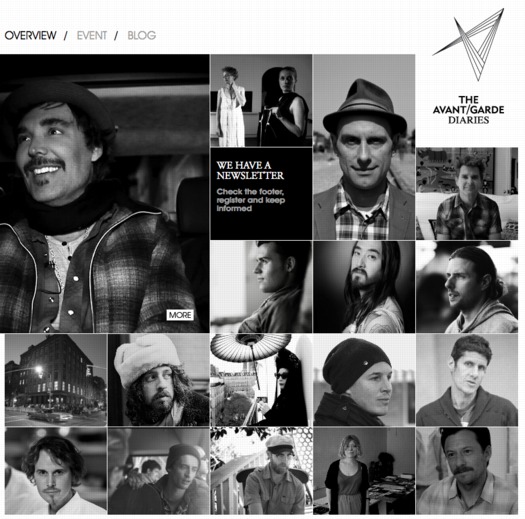
Which is not to imply that The Avant/Garde Diaries was created by Mercedes just to launch one new mid-market sedan; it's really a platform for shifting the cultural perception of the Mercedes brand itself. Taken as a whole, The Avant/Garde's Diarists appear to be rebellious, creative, successful, in their late 30s and early 40s, prone to wearing large plaid, white with a token Asian--and almost exclusively male. It's an aspirational lifestyle profile from which you can neatly reverse engineer the Mercedes driver profiles the company's trying to counterbalance: suburban yoga moms, Orange County realtors, Hamptons d-bags, and unsettlingly blingy black folk.

diptych via notcot
It's also an attempt--and in Transmission LA's case, a literal one--to make peace with a generation and culture which once considered Mercedes Benz as the contemptuous Other, the target of their scornful, youthful mischief, and to bring them--and their upscale families--into the corporate fold. And so a rapper who once encouraged his fans to turn stolen hood ornaments into necklaces is hired to make official versions for the Brand Communications team and party VIPs. And is provided with giant, authentic Mercedes logos to scatter about the galleries, and to dangle from gold chains on the front of the museum.
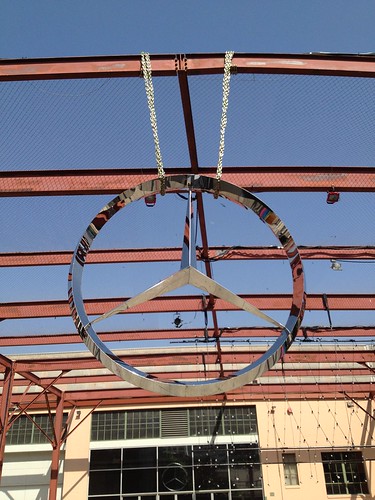
image via shapthings' flickr
[No doubt too late disclosure: I just sold one of our Mercedes; I trust the one that's left is so boring as to be aspirational to no one.]
And this is all of a piece, not just with Deitch's strategy for MOCA, "guest curators" and all, but with his conception of art and its role in the culture. Speaking to Mike Boehm in March, Deitch cited the fundraising difficulties faced by academically focused shows like Ends of the Earth:
It's much easier, he said, to raise money for shows by popular figures, "where collectors are excited about the artists and brands want to be connected to the artists' image. Fundraising for historical shows with great artists who don't include today's art-world stars is a great challenge."It's a sentiment that comes up in The Avant/Garde Diaries' latest video featuring 90s magazine photographer David LaChapelle and Berlin dealer Reiner Opoku, aptly titled, "Reinventing Yourself":
[Opuku]: I'd say recently, we see a lot of need for certain brands--or the desire for brands to work with creative people. First of all, you have to find a language between these two: between the creator and the brand. Therefore you need people in between, who, let's say, orchestra [sic] the whole enterprise, the whole idea.LaChapelle's reboot as a fine artist began, as you might guess, with a 2005 sideshow/"retrospective" at Deitch Projects. It's all enough to make me wonder how deep and ongoing Deitch's involvement with Mercedes' marketing is.
More importantly/depressingly, it makes me wonder if there really is anything to be done about it. Transmission LA includes several artists I actually like, respect, or at least take seriously. Even Hans Ulrich Obrist has done a video for the Avant/Garde Diaries [which rather succinctly demolishes Aaron Rose's defense of MOCA in the name of forgetting the irrelevant past. Count me as Team HUO on this one, obviously.]
Here's Peter Saville shooting down the fantasy of a contemporary avant-garde in--what else?--his video for The Avant/Garde Diaries, titled awesomely, "Disco Ball of Everything":
This last decade, we've had a broadly pluralist culture. Basically, we have a kind of, entirely multi-track system. The system has evolved to encompass all forms of provocation. We've entirely commercialized--and commoditized--life culture. It's perfectly understood now that you will dress any way you like. You can have dance music with rock music with classical music. All of these genres in a multi-faceted, contemporary kind of reality. Like a kind of disco ball of everything.If only Saville would curate MOCA's show.
Meanwhile, museums seemingly not in peril have negotiated far-ranging sponsorships with car companies, from VW's multi-year deal with MoMA and PS1 to BMWGuggenheim's globehopping program on urban design. But MOCA's Mercedes tie-up doesn't remind me of these more traditional underwriting agreements. The closest analogue I can think of is YouTube's complicated content/sponsorship/museum rental relationship with the Guggenheim for the YouTube Play Biennial in 2010. [For Mercedes' part, nothing beats Arne Quinze's Uchronian campaign at Burning Man for the 2007 Lexus LS460 for inspiration in developing a long-term, stealth co-optation of a non-commercial art context for a car launch.]
Is MOCA really only guilty of indelicate execution? Are the differences between Deitch's boundary blurring antics and the rest of the art/museum world's stimulation-seeking, crowd-pleasing, and corporate sponsor-pleasing differences of kind, or merely of degree? These are questions I've been grappling with as MOCA's credibility has been disintegrating in front of me.
On the one [personal] bright side, it makes me feel slightly better, more aware and critical, and slightly less implicated, to have made this giant, blingy sculpture, which is now hanging in my living room:

Untitled (MOCA Mercedes, after Mike D), 2012, ed. 10
Like the Thomas Hirschhorn chain sculptures which were its inspiration, this is made from cardboard, aluminum tape, gold foil, and packing tape. As such, it's designed to last just long enough to serve its purpose, to be considered, favored, consumed/shown, and flipped a few times at auction. Anything longer than that will be a problem for the conservators, assuming such a position exists in the museum of the 21st century.
This one, I think I'll keep for my self, but I suppose I'll make a few more. The price'll go up after Deitch leaves, with the increase going to MoCA.
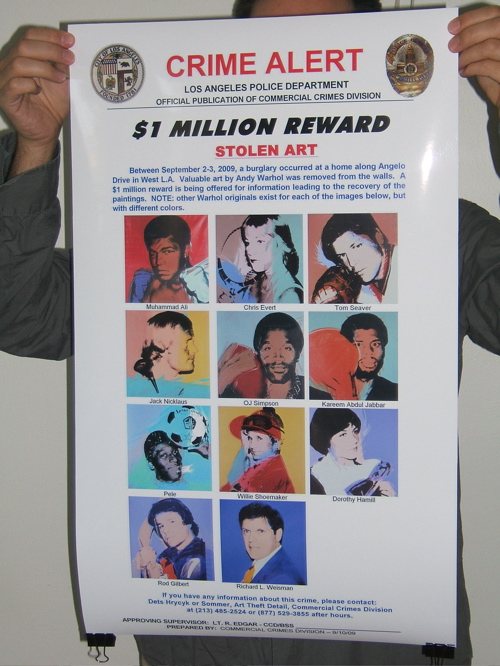
Almost three years ago now, a suite of ten Athlete paintings [plus one] by Andy Warhol was stolen from the Bel Air dining room of collector Richard Weisman. In an effort to help find them, I created a grass-roots campaign via the then-new service Kickstarter, to print giant versions of the LAPD Art Crimes Division's utterly awesome wanted poster, and to post them all over the world, wherever Warhols were traded or shown.
Unfortunately, that Kickstarter campaign failed. And the Warhols remain missing, though Weisman has stopped cooperating with police, complicating their investigation.
And though it's unlikely that I was the first to run an unsuccessful campaign, I could at least feel a sense of accomplishment at being the first to use a Kickstarter campaign as a medium for art critical commentary.
And that was that until a few months ago, when the noted Swiss designer and publisher Lex Trueb contacted me, and asked if I would mind his including my Find The Warhols poster project in an exhibition in London.
The Museum of Design Zurich had invited Trueb and 11 other designers to participate in London - Zurich Posters, an exhibition at the House of Switzerland London, a national pop-up venue for the 2012 Olympic Games.
Rather than create some sportsy thing from scratch, Trueb was more interested in appropriating an existing sports- or Olympics-themed poster design of some kind. The Find The Warhols wanted poster, he thought, would fit the bill nicely.
Trueb made his proposal to the curators, they went for it, and though I haven't seen installation shots yet to see how it turned out, Lex says the giant-size poster looks pretty awesome. He laid a brief statement of mine along the side of the poster for a bit of context, but otherwise, it's entirely true to the LAPD's great tradition of stolen art wanted poster design.
As someone who's been appropriating or copying or re-creating stuff originally made by others for a while now, it's been an interesting experience having a proposal of mine [albeit an appropriated one] appropriated by someone else. Whatever trepidation I might have had about it can't compare to the amazement at the serendipity of Lex's interest and his show and the rather incredible context. His respect and seriousness about my own relationship and project vis a vis this found object poster is also above and beyond. He could have easily tracked down the original poster and stuck it in his show, and I'd probably be none the wiser. But he's been awesome. The moral is, when someone takes you and your idea seriously enough to appropriate it, it can be a net positive for everyone.
Anyway, if you're in London before the 12th, and near Southwark, maybe looking for a place to watch Federer play for Switzerland's first gold medal, please check out the poster show and tell me how it looks.
London - Zurich Poster Exhibition, through 12 August 2012 [houseofswitzerland.org]
August 2, 2012
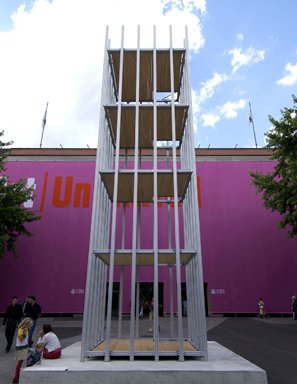
It's been installed on his Topanga Canyon compound for a while, but Chris Burden's Small Skyscraper (2003) will be on view in Pasadena, at the Armory Center for the Arts. Its dimensions, 35 feet high, with <400sf of floor area, were determined by the LA County zoning regulations for the largest structure allowed without a building permit. The work arose out of bureaucratic frustrations Burden faced when trying to construct a studio on the rural property he bought in 1991.
Though the Armory Center's website calls it "quasi-legal," noting that the outbuilding exemption Burden used has since been changed. And it's not clear that his "hypothetical domestic use" or "added design features, such as a low roof parapet" ever complied with the code in the first place.
Once it crosses his property line, then, instead of this function-based envelope pushing, Burden's transgressive interest transmutes into the sculptural. As he told Helen Stollas for The Art Newspaper,
At first, they [i.e., Burden and the architects Linda Taalman and Alan Koch, who approached him about showing an unrealized architectural project] considered developing it into an actual habitable structure, with sliding glass doors and a one-man elevator. "But I pulled back from that. I like it as more of a sculpture in the shape of a building," he says. "It's in that grey zone it; it could be a building, but when Mr Inspector comes knocking you say, 'Well, that's not a structure, it's art.'"Which neatly mirrors an actual legal battle being waged at the same time in Southport, Connecticut, where the local historic district filed suit claiming that the 40-ton concrete & rebar sculpture collectors Andrew and Christine Hall had installed on their waterfront property constituted a "structure" and thus required a [love this] "certificate of appropriateness." [The State Supreme Court agreed with the town's argument that it had jurisdiction because the sculpture "is 'affixed' to the land by virtue of its own 'multi-ton weight' and the force of gravity" (emphasis added for awesomeness). The Halls removed the sculpture, loaning it to a 2007 Kiefer exhibition at Mass MOCA.]
Burden's building code experiment also serves as a nice, East Coast-West Coast, LA throwdown to New York's OG, the grandmaster of all zoning envelope illustrators, Hugh Ferriss.

The Four Stages, Ferriss's 1922 renderings of the Zoning Code of 1916, not only revealed to architects and developers how New York's first skyscraper regulation constrained the size and shape of their projects; they predicted the city's envelope-maximizing future.
Which is nice, because Burden says there's talk of bringing Small Skyscraper to New York. He told Stollas that there are actually two extruded aluminum-and-2x4 Small Skyscrapers now: the California one, built for a 2003 exhibition at LACE and since installed in Topanga; and a European one, installed for ten days in Art Basel in 2004. "Since it was cheaper to just buy new materials when the work was shown in Switzerland, rather than ship the existing work over."
Look, I'm as stoked as the next guy to see Burden's sculpture, but why would any exhibition of it be predicated on the mere existence of two of them? Will it ever be cheaper to transport a Small Skyscraper than to build it locally? No. So why not build it? Why not build a hundred of them, a thousand, all over the place, a distributed city of Small Skyscrapers, wherever the zoning allows?
Or why not turn them into a platform, use Small Skyscraper's beautiful, minimalist, economical form to map out the invisible bubble of unregulated space and use across the country? Just type in your zip code, and the Small Skyscraper website will automatically generate plans for you to build the biggest permit-free structure/sculpture/structure/sculpture possible in your jurisdiction, too. Marin's would be a doghouse, invisible from the street, while Houston'd be all hey hey, how big you want it? [If you get sued or fined, though, you're on your own.]
But I guess that's my project, not Burden's. Actually, it also turns out to be the dream of Columbia GSAPP's Kazys Varnelis, and probably of any and everyone who's ever bloodied his head against a building code:
Perhaps, we imagine, after a confrontation with the authorities, Burden's audacity might be accepted as his own business and, as our fantasy continues, we hear the sounds of construction in backyards citywide as hundreds, even thousands of small skyscrapers rise into the sky, turning the city into a latter day San Gimignano.The reason Burden says "there is some talk of bringing them to New York" has less to do with Ferriss or LA or architectural libertarianism, and everything to do with the fact that there are now two Small Skyscrapers. And, because, as "Burden adds, when installed together, they somewhat resemble the Twin Towers."
Sulcptural skyscraper build through a legal loophole [theartnewspaper]
Chris Burden | Small Skyscraper runs from 8/11 [through 9/11] til 11/11 [armoryarts.org]